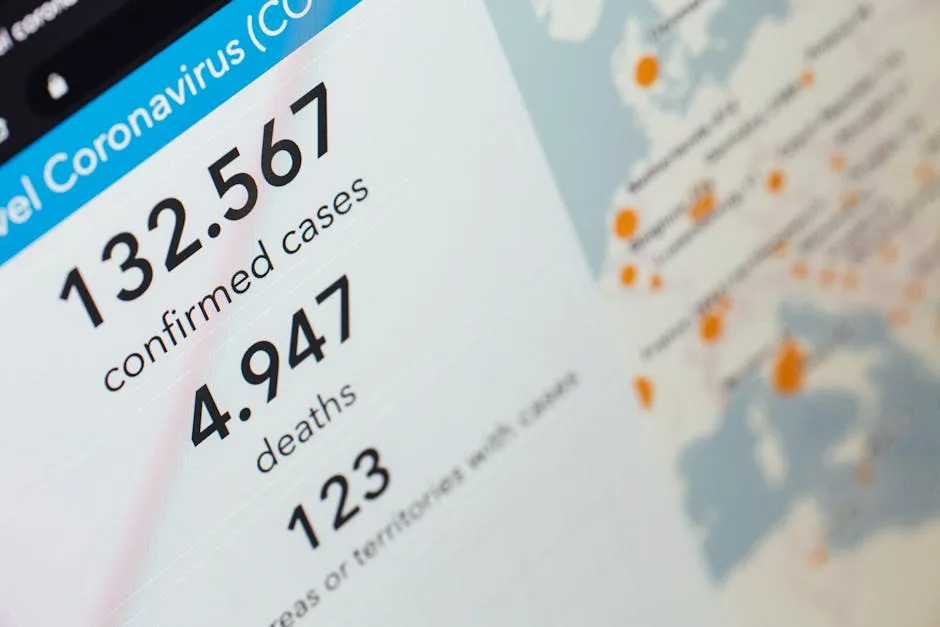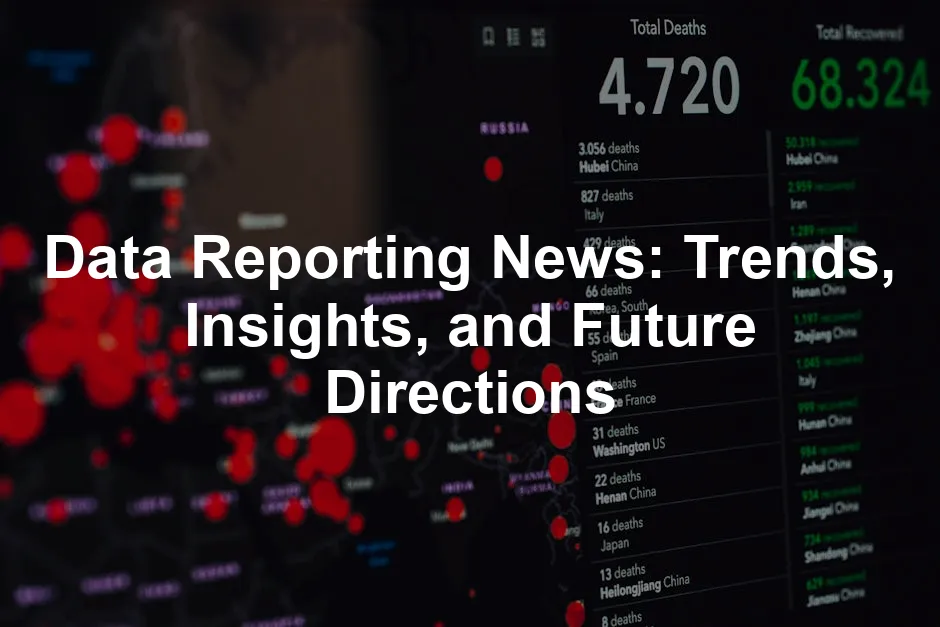Introduction
Data reporting is transforming journalism today. It emphasizes facts over opinions, creating a more informed public. This shift is crucial as audiences crave transparency in their news consumption. Journalists now use data to tell compelling stories, making complex information accessible. As data-driven storytelling takes center stage, data literacy becomes vital for both journalists and consumers.

Summary and Overview
Over the past decade, data journalism has evolved significantly. It combines traditional reporting with advanced data analysis techniques. This fusion enhances the storytelling process, making news more engaging. Recent statistics show that audiences increasingly prefer stories backed by data. For instance, surveys indicate that 70% of readers are more likely to trust articles that incorporate data. This article will cover key themes, including the importance of data in journalism, its evolution, and current trends in data reporting.
Understanding effective data analysis is crucial for journalists. Learn more about effective data analysis techniques.
The Importance of Data Reporting in Journalism
The Role of Data in Modern News
Data is essential in enhancing news credibility. It provides depth and context, helping journalists convey complex issues effectively. Accurate data collection and analysis are vital to maintain trust in journalism. A recent survey shows that 60% of readers believe data-driven articles are more trustworthy. This trend reflects a growing expectation for transparency in reporting. As consumers, we must consider the data behind the news we consume.

Evolution of Data Journalism
Data journalism has a rich history, evolving from traditional reporting methods. Key milestones include the rise of computer-assisted reporting and the adoption of data visualization. The past decade has seen significant growth in data journalism, with many media outlets investing in data teams. According to recent reports, over 50% of news organizations now employ data journalists. This evolution highlights the increasing value of data in storytelling. Explore examples of successful data journalism to see its impact firsthand.
To enhance your data analysis skills, consider investing in Tableau Software. It’s a powerful tool that allows journalists to visualize data effectively, making complex datasets more digestible for their audience.
Key Trends in Data Reporting
Increased Use of Visualizations
Data visualization tools are booming. They transform raw data into engaging stories. Infographics, interactive charts, and maps help convey complex ideas. Visual aids capture attention and enhance understanding. Studies show that articles with visuals have higher engagement rates. In fact, visuals can increase audience retention by up to 80%. This shift is crucial as readers prefer digestible content.

To create compelling visualizations, consider tools like Canva Print or Flourish Data Visualization Tool. These platforms simplify the process of turning data into stunning graphics. They allow journalists to present information clearly and attractively.
Data as a Source of Narrative
Data shapes narratives in journalism. It helps uncover hidden stories and trends. Finding meaning within datasets is essential for impactful reporting. Journalists must think creatively when analyzing data. This approach connects audiences to the information emotionally. Successful case studies demonstrate how data-driven storytelling resonates with readers. For instance, the New York Times used data to illuminate the effects of climate change, enhancing public awareness.

Journalists should explore diverse data sources. Government databases, social media analytics, and public records offer valuable insights. Embracing these resources can lead to powerful narratives. For those looking to dive deeper into the world of data storytelling, consider picking up a copy of The Verification Handbook. It offers practical advice for journalists on maintaining integrity in their reporting.
Exploring various data sources can enhance storytelling in journalism. Learn more about comparing data sources.
Addressing Challenges in Data Journalism
Data journalism comes with its challenges. Journalists often face issues like data quality, access, and interpretation. Inaccurate or biased data can mislead audiences. Moreover, the abundance of misinformation poses ethical dilemmas. A recent survey revealed that 55% of the public is skeptical about data accuracy in news reporting.

To tackle these challenges, journalists must prioritize data cleaning and verification. Implementing best practices for data accuracy is crucial. Resources like the Verification Handbook can guide journalists in maintaining integrity. By addressing these issues, reporters can build trust and credibility with their audience.
For those who want to analyze data more efficiently, consider using Statistical Software like SPSS. It can help streamline the analysis process and improve the accuracy of your reports.
Improving data accuracy is essential for trustworthy journalism. Discover solutions for enhancing data accuracy.
Future Directions of Data Reporting
The Role of Artificial Intelligence
Artificial intelligence is reshaping journalism profoundly. It’s changing how we collect, analyze, and report data. In newsrooms, AI tools assist in breaking down vast datasets efficiently. Automated reporting systems can generate news stories in real-time, saving valuable time for journalists.

However, ethical concerns arise alongside these advancements. Questions about bias in algorithms and the accuracy of AI-generated content are pressing. Journalists must ensure that AI tools enhance transparency, not obscure it. As we embrace AI, it’s essential to maintain a balance between technology and ethical responsibility.
Statistics indicate that AI will impact journalism significantly. By 2025, experts predict that over 50% of news articles may be generated or supported by AI. This shift could lead to faster reporting and more personalized news experiences.
What are your thoughts on AI in journalism? Share your insights in the comments below!
The Importance of Data Literacy
Data literacy is crucial for today’s journalists and audiences alike. As news increasingly relies on data, understanding it becomes essential. Journalists need the skills to interpret and analyze data effectively. This empowers them to tell richer, more informed stories.

Initiatives are underway to enhance data skills in journalism education. Many universities now offer courses focused on data analysis and visualization. Training programs are popping up, aiming to equip journalists with the necessary tools. If you’re interested in enhancing your data skills, consider reading Data Science for Dummies. It’s a great resource to get started!
Statistics reveal that only 30% of journalists currently feel confident using data in their reporting. This gap highlights the need for continued education and skill development.
If you want to boost your data literacy, consider enrolling in a workshop or an online course. These resources can help you navigate the evolving landscape of journalism. What skills do you think are vital for modern journalists? Let us know in the comments!
Conclusion
In this article, we discussed the significance of data reporting in journalism. Data journalism enhances storytelling by grounding narratives in facts. It fosters transparency, which is increasingly demanded by audiences today. As technology evolves, so does data journalism. This evolution is essential for future storytelling, providing deeper insights into complex issues.

Encouragingly, readers can play an active role in this landscape. By seeking out reliable data sources, you can better evaluate the news. Critically analyzing the data behind stories helps cultivate a more informed public. So, let’s continue to prioritize accuracy and transparency in our news consumption.
FAQs
What is data journalism?
Data journalism is the practice of using data to tell stories in journalism. It involves analyzing data sets to uncover insights and enhance reporting.
How has data reporting changed in recent years?
In recent years, data journalism has become more accessible due to technological advancements. Tools for data visualization and analysis have improved significantly, empowering journalists to create compelling narratives.
What tools can journalists use for data reporting?
Journalists can utilize tools like Tableau, Google Data Studio, and Flourish for data visualization. Additionally, software like Excel or Google Sheets helps in data analysis and management.
How can data journalism improve audience trust?
Accurate data reporting enhances credibility. When news is supported by verified data, it builds trust among readers, making them more likely to engage with the content.
What challenges do journalists face with data?
Journalists often encounter challenges such as data quality issues, access limitations, and misinterpretation of data. To address these, it’s crucial to prioritize thorough data cleaning and verification processes.
Please let us know what you think about our content by leaving a comment down below!
Thank you for reading till here 🙂
All images from Pexels




